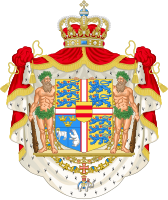File talk:Royal Coat of Arms of Greece.svg
Jump to navigation
Jump to search
Accuracy
[edit]Forgive me for saying this, but the current file is not very accurate in its representation of the Coat of Arms. Based on my knowledge, the Greek royal crown was not the same as the Danish royal crown (featured on the current file), and the mentle is also the same as the one on the Danish Coat of Arms. Based on the coat of arms on the website of the Greek Royal Family (here), I have crreated a more accurate version of the file. I did not want to upload it immediately over the current file, as people many see issues and want to discuss this further.
| Danish file | Current Greek file | My file |

|

|

|
Thoughts? --Philly boy92 (talk) 21:17, 25 July 2011 (UTC)
- Okay..... please see the discussion concerning the crown and others here. And the issues of 'accuracy' here. Sodacan (talk) 01:10, 26 July 2011 (UTC)
- There is no need to get touchy, your work is excellent and obviously superior to mine. I was merely saying that I believe it would be more prudent to base the file on the actual coat of arms, much like you have done with the Danish one for example. I'm sure we all appreciate your services to wikipedia, but I believe actual official examples should be taken into serious consideration and not overlooked for the sake of creating a more aesthetically pleasing result. As for the crown, there is no evidence to suggest that the actual crown of Denmark was used. If anything, a Bavarian-style crown was usually used, and this is evident in banknotes, posters, in parliament, official documents, flags, officer's caps, postal stamps, official portraits and in documents even while Constantine was still reigning. — Preceding unsigned comment added by Philly boy92 (talk • contribs) 02:27, 26 July 2011 (UTC)
- I wasn't being touchy at all actually. I value your input very much - but I just do not want to explain all the issues all over again. Anyway, back to the main issue- since then, my opinion regarding the crown has change and I now agree that there is a graphical representation of it quite distinct from the Danish one, whether this is based on Otto's crown is very interesting one. The version on the Greek Royal Family's official website is certainly a good candidate for an official version, but I am reluctant to follow it blindly, since I was not too sure before. There are many different variations of the official arms, floating all over the internet. That particular version lacks the ribbon and star of the Order of the Redeemer (which is now used by the current Greek State), so I assumed that the version only depicts the dynastic arms of the personal Royal House and not of the Kingdom itself. To only follow this version, and ignore all others- is certainly a valid argument and I can agree to that if you feel particularly strongly about it. But my reasoning when I made this coat of arms was to create as complete a record as possible of all the accoutrements and features of the arms for heraldic study, and not to copy anybody else's. Otherwise, it would indeed be more prudent to upload a copy from the website as it is, since that version is the most accurate- and nothing I make could ever hope to compete with it. Sodacan (talk) 03:34, 26 July 2011 (UTC)
- Thank you for explaining this, I understand the logic behind your choices now. However, I do believe that the crown issue would need to be addressed at some point, the discussion on the other talk page did not go anywhere to my knowledge. I found this picture of the marriage of Constantine II and Anne Marie, the crown appears to be particularly "Greek", as it features religious figures in a Byzantine style (at least thats what it looks like to me). By the way sorry if I came out pushy or judgemental of your work, it was not my intention. --Philly boy92 (talk) 01:14, 28 July 2011 (UTC)
- Just to avoid confusion, the marriage crowns are not the royal crowns. They are a traditional part of Orthodox weddings, although in the royal family's case, they do indeed look like royal crowns. IIRC, they belonged to Queen Olga and hence reflect Russian tradition. Constantine ✍ 08:40, 28 July 2011 (UTC)